AMD Ryzen 7 8700G and Ryzen 5 8600G Review: Zen 4 APUs with RDNA3 Graphics
by Gavin Bonshor on January 29, 2024 9:00 AM EST- Posted in
- CPUs
- AMD
- APUs
- Phoenix
- 4nm
- Zen 4
- RDNA3
- AM5
- Ryzen 8000G
- Ryzen 7 8700G
- Ryzen 5 8600G
CPU Benchmark Performance: AI and Inferencing
As technology progresses at a breakneck pace, so too do the demands of modern applications and workloads. With artificial intelligence (AI) and machine learning (ML) becoming increasingly intertwined with our daily computational tasks, it's paramount that our reviews evolve in tandem. Recognizing this, we have AI and inferencing benchmarks in our CPU test suite for 2024.
Traditionally, CPU benchmarks have focused on various tasks, from arithmetic calculations to multimedia processing. However, with AI algorithms now driving features within some applications, from voice recognition to real-time data analysis, it's crucial to understand how modern processors handle these specific workloads. This is where our newly incorporated benchmarks come into play.
As chip makers such as AMD with Ryzen AI and Intel with their Meteor Lake mobile platform feature AI-driven hardware within the silicon, it seems in 2024, and we're going to see many applications using AI-based technologies coming to market.
We are using DDR5-5200 memory as per the JEDEC specifications on the Ryzen 7 8700G and Ryzen 5 8600G, as well as DDR4-3200 on the Ryzen 7 5700G and Ryzen 5 5600G. The same methodology is also used for the AMD Ryzen 7000 series and Intel's 14th, 13th, and 12th Gen processors. Below are the settings we have used for each platform:
- DDR5-5200 CL44 - Ryzen 8000G
- DDR4-3200 CL22 - Ryzen 5000G
- DDR5-5600B CL46 - Intel 14th & 13th Gen
- DDR5-5200 CL44 - Ryzen 7000
- DDR5-4800 (B) CL40 - Intel 12th Gen
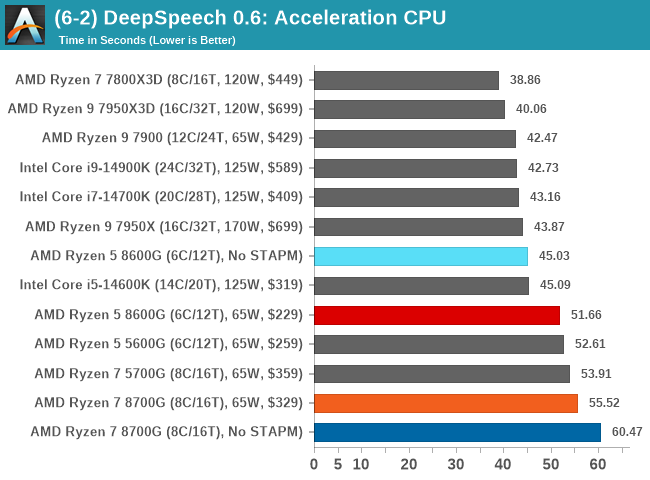
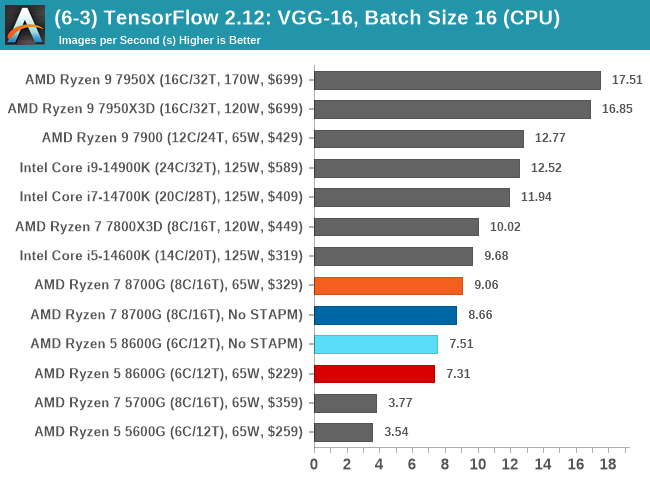
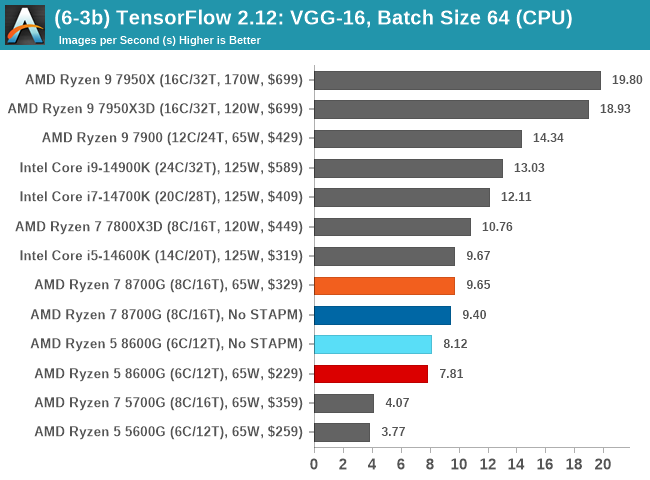

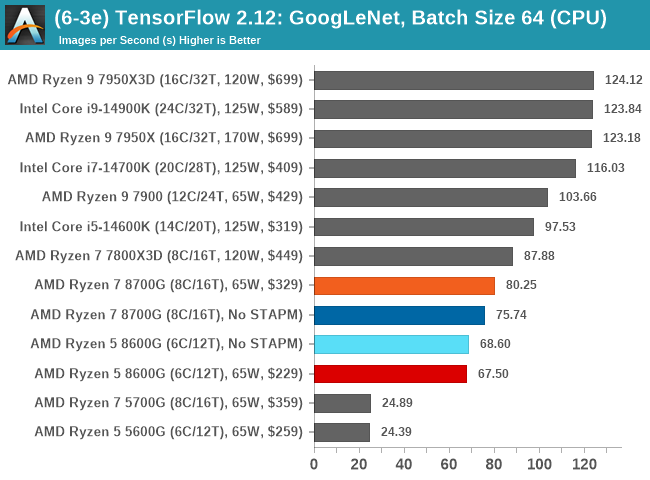

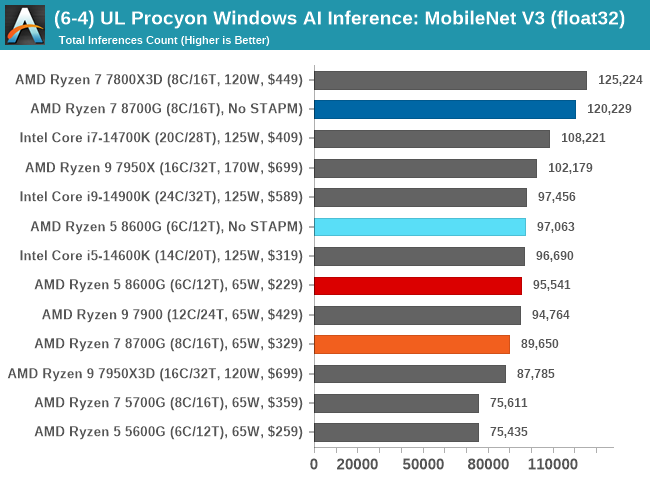
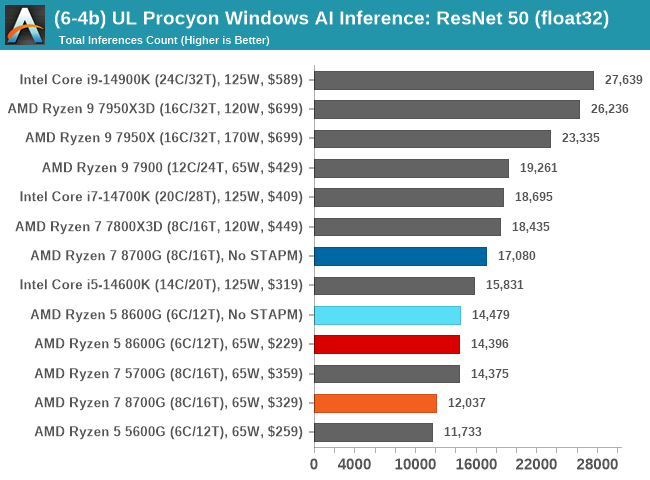
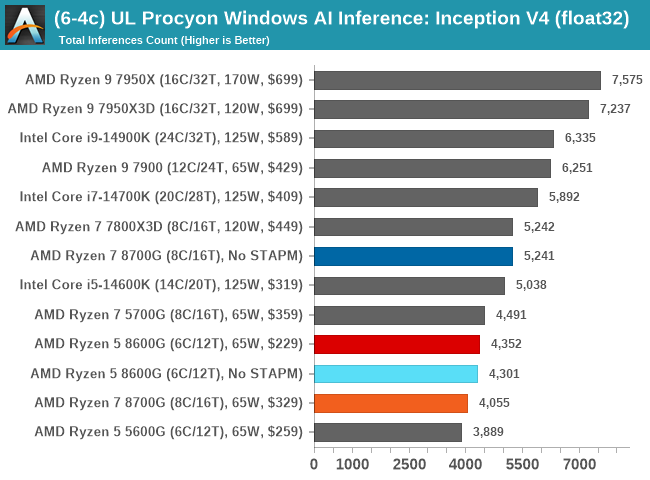
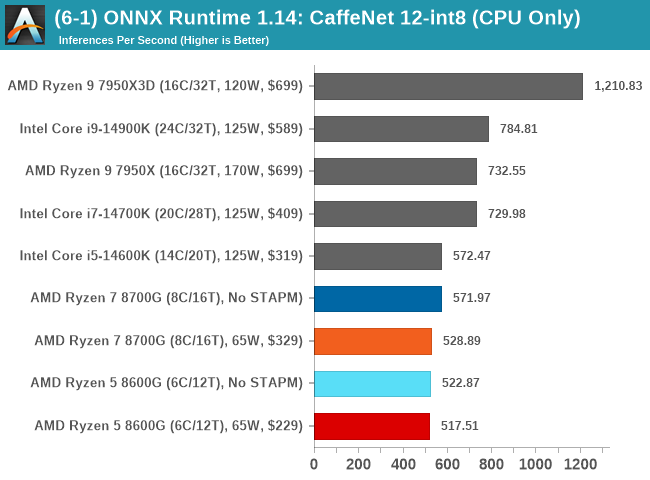
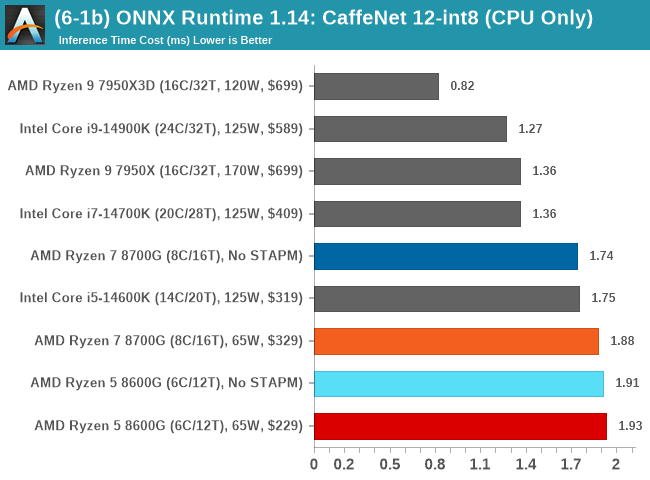
A major focal point of AMD's Ryzen 8000G series is the inclusion of the Xilinx-based Ryzen AI NPU. While AI benchmarks and those measuring capabilities using large language models (LLMs) are thin off the ground, none of our benchmarks utilize the NPU itself. Much of the Ryzen AI NPU is based and, as such, is focused on enabling software features such as those generative AI capabilities within Microsoft Studio Effects and software such as Adobe and Davinci.
In ONNX Runtime using the utilized INT8 model, we can see that the Ryzen 7 8700G and Ryzen 5 8600G don't offer world-beating AI performance, but we intend to investigate this more deeply.
Using the latest firmware, which removes the STAPM limitations, we can see that the Ryzen 5 8600G shows the most gains, especially in DeepSpeech 0.6, where we saw a 12% bump in performance. The Ryzen 7 8700G also posted some very impressive gains in the UL Procyon Windows AI Inferencing benchmark, with a 34% jump in performance in our charts, but this could be a case where it underperformed in the MobileNet V3 test in the first place.










111 Comments
View All Comments
TheinsanegamerN - Wednesday, January 31, 2024 - link
If its being sold as a desktop chip it should be compared against the desktop chips it is competing against. If I am building a mini desktop with an APU the 7840u is irrelevant.meacupla - Wednesday, January 31, 2024 - link
Which, again, is hilarious.The facts point to 8700G and AM5 platform costing too much to make sense. If you want a cost effective gaming setup, you are better off with an i3 or R5 with dGPU.
8700G's one niche is ultra compact mITX without a dGPU. But if you go that route, it's now competing with.... oh look at that, the mini-PC segment.
maxijazz - Saturday, February 3, 2024 - link
Low power APUs as 7840, 8x00G are perfect for fanless (noiseless) mini desktops (audio servers) used in (so called) computer-audio industry, audio-hobby. Intel sucks in these applications recently.ermg_chips - Tuesday, January 30, 2024 - link
What I'm wondering is, are they going to come out with an 8700GE, 8600GE, etc eventually? The 5xxxGE series were the same CPUs but with a TDP set to 35W to fit in the same ultra-compact systems that the 35W intel -T chips do.I have a weird reason for caring, I live a nomadic/unstable lifestyle but still like to self-host all my shiz, so cramming as much compute into a "1 liter" PC as possible is important to me, and at my price point, I've been very happy with a 5750GE in a HP EliteDesk Mini stuffed with RAM as a teeny Proxmox box.
FWhitTrampoline - Monday, January 29, 2024 - link
It's just too bad that Intel did not release any 65W Meteor Lake S Socket Packaged variants As I would rather have built the Intel variant of the ASRock Desk Mini with Meteor Lake instead. And I have to LOL that the Tech Press can only Show the CPU only Blender 3D Cycles Rendering tests as there's no Radeon iGPU ROCm/HIP support for any Blender 3D iGPU accelerated Cycles Rendering testing.And Intel's Meteor Lake iGPUs have proper and working iGPU compute API support via Intel's OneAPI/Level-0 whereas on Linux AMD's ROCm/HIP GPU compute API support is just not there for Radeon iGPUs or for most Consumer Radeon dGPUs currently.
TheinsanegamerN - Tuesday, January 30, 2024 - link
It still wont fit in your in win chopin.FWhitTrampoline - Tuesday, January 30, 2024 - link
I do not own an Inwin Chopin but I do own an ASRock X300 Desk Mini and having to Blender Cycles render on the CPU cores and it's just too much for that OEM cooling solution to handle on the x300 sans any thermal throttling. But Because of the lack of Proper AMD ROCm/HIP support there for the Vega iGPU I can not make use of that for Blender 3D iGPU accelerated Cycles rending where there's plenty more FP units on the iGPU to accelerate the Ray Tracing calculations(Ray Tracing is a Compute Intensive workload).And I love how the Tech Press utilizes Blender 3D's CPU Cycles rendering as a CPU stress test and totally ignores any Blender 3D iGPU and dGPU Blender Cycles rendering tests to the point where that's basically ignored and an uncovered subject for the most part. But at least Intel cares more for creators there than AMD! Intel's got it's iGPUs support for Compute Workloads on Linux via OneAPI and Level-0 while AMD just lets the console makers to the hard part of tweaking AMD's APUs for Gaming Graphics workloads only!
But I'm going to have to wait for Arrow Lake to get any Socket Packaged Intel SKUs with the better Tile Based Graphics on a Desktop/Socket Packaged offering!
meacupla - Monday, January 29, 2024 - link
When you compare the 8700G results to 7840HS (Beelink GTR7), the performance difference is negligible.It seems to me that if you don't pair the 8700G with premium RAM, you would be further wasting your money.
t.s - Tuesday, January 30, 2024 - link
Seconded! With better power consumption too.AndrewJacksonZA - Monday, January 29, 2024 - link
Question: If a person has an APU, why use Blender CPU only?So on float8, there's a 2% difference between the 8700G and the i7-14900K. Wow.
Thank you